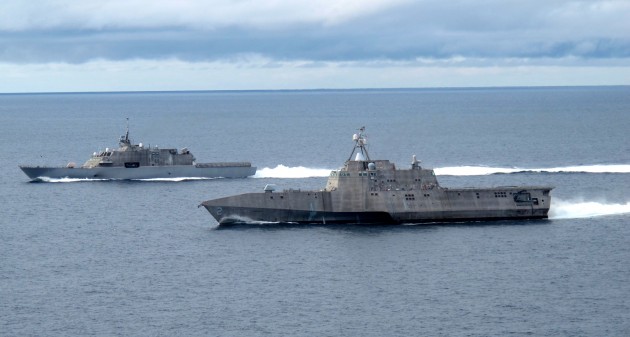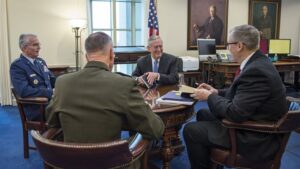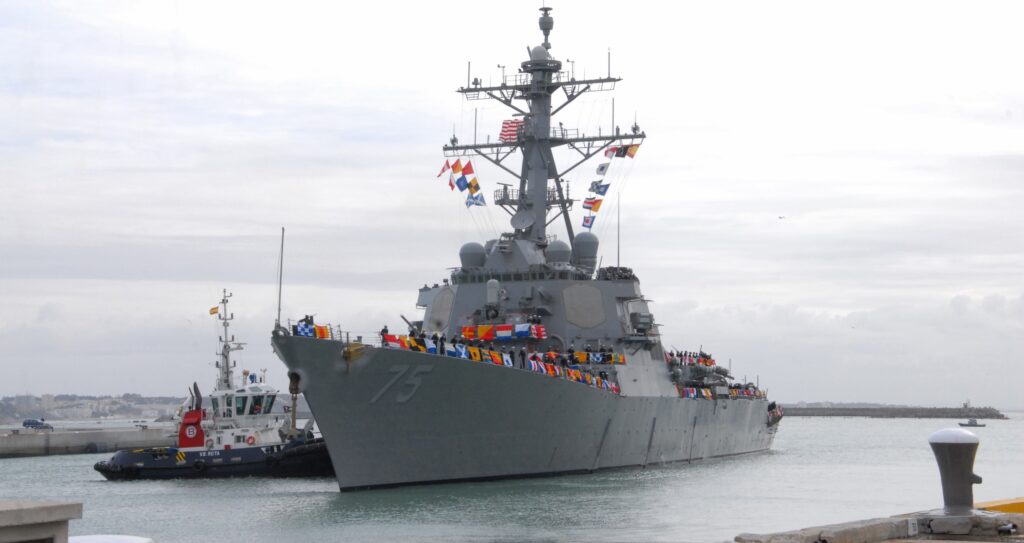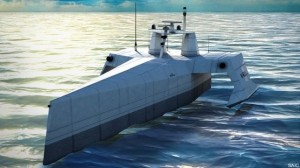
President Trump speaks to Newport News Shipbuilding employees above the carrier FORD.
WASHINGTON: All hands, brace for disappointment. The president’s promised naval buildup won’t begin in the 2018 budget out next week — or maybe ever.
Sure, before the election, candidate Donald Trump promised a 350-ship Navy. Sure, just this morning, House Speaker Paul Ryan repeated the 350 figure. Sure, this week the Chief of Naval Operations emphasized the buildup should and could be fast.

Adm. John Richardson
US shipyards could deliver 29 additional ships over the next seven years, said the CNO, Adm. John Richardson. That averages to 4.1 additional ships per year, although the first years would probably be lower because the shipyards need time to ramp up, especially for the largest vessels such as aircraft carriers.
So how many additional ships are actually in the 2018 budget? Leakers say one, maybe two: a $1.8 billion Aegis destroyer, definitely, and a $550 million Littoral Combat Ship, possibly.
[UPDATE: The 2018 budget rolled out May 23 actually included no new ships, but the next day, the Navy announced the administration would now “support” a second LCS in the FY18 request, although how it would be funded remains unclear.]
Admittedly, the extra ships might be added by Congress or lurk in the outyears, the traditional refuge for promises unfulfilled. But we won’t have any way to know because, if the leakers are right, the administration won’t submit the traditional five-year spending projections — the Future Year Defense Plan or FYDP — when they submit the 2018 budget.

The two Littoral Combat Ship variants, LCS-1 Freedom (far) and LCS-2 Independence (near).
The sotto voce official justification is the number of ongoing strategic reviews, but the nagging suspicion is this is another sign of Trumpian disarray. Without a deputy Defense Secretary (Bob Work is the acting deputy) or comptroller in place, it’s hard work to put together the enormous range of choices required of a five-year budget.
Whatever the reason, the lack of a FYDP makes it impossible for the press or Congress to put the 2018 plan in any kind of context, reducing long-term forecasts to, “take our word for it.”

Defense Secretary James Mattis at his first meeting at the Pentagon. Acting Deputy Secretary Robert Work is at right.
Adm. Richardson did give Trump a little wiggle room to start the real buildup in 2019. “First, we need a year to consolidate our readiness and achieve better balance across the Navy. 2018 will be that year,” Richardson wrote in a white paper released Monday. That fits with Defense Secretary James Mattis’s insistence that repairing readiness must be the first priority, not modernizing and growing the force — although it’s hard to separate readiness from modernization when so many people, planes, ships and tanks have been ridden so hard for so long.
On the other hand, the full sentence in Richardson’s white paper reads (emphasis ours): “2018 will be that year, and even as we restore wholeness, we’ll ensure that we continue to grow the Navy and establish a firm foundation for accelerating growth in following years.” Now, “continue to grow” could mean continuing to grow at the same rate at the Obama administration plan in 2018 — in which case any additional ships in ’18 are a pure bonus — followed by “accelerating growth” in 2019 and after. But the overall emphasis is unmistakably on speed.
“By any measure, the near-term signal should be that shipbuilding is very important,” Richardson told reporters Monday. “The industrial base is capable of doing more, and we’ll be proposing our best way to get there as quickly as we can.”

The destroyer USS Cook arrives in Rota, Spain
The Navy wants not only faster growth, it wants more growth than the 350-ship figure that’s become Republican orthodoxy.
“We agree with that number,” Speaker Ryan told the Hugh Hewitt Show this morning. “We never rubber stamp everything that an administration wants on every line item of spending….. But on the level of funding, I can tell you this. It’s my strong opinion that we will not produce a lower number than what the administration is producing…. As you know, since 2012, I’ve endorsed the number 350.”

Rep. Paul Ryan
350 is the figure from a Heritage Foundation study that underlay most of Trump’s 2016 platform on defense. But in December, the Navy came out with an official Force Structure Assessment that said they needed 355, followed by three congressionally chartered studies — one by an independent Navy team, two by thinktanks — that called for even more, up to 462 manned and unmanned vessels. “As all the studies look forward,” Richardson told reporters, “there’s a consistent conclusion that the Navy must be more powerful and larger.”
This is not a crude pitch for quantity over quality. To the contrary, Richardson said in the white paper and to the press that we need not only more ships, but ships that are both more powerful individually and linked to a network of manned craft, robots, sensors, and weapons that is more than the sum of its parts.
“While we need a bigger fleet, we also need a bit of a different fleet, one that will be able to fight in new ways,” the admiral said. “My sense is that we’re on the dawn of something very substantial in terms of naval warfare. Something as substantial as the transition from sail to steam…There is a new dimension to naval warfare now which is the power of networking all of those platforms together.”

DARPA’s Sea Hunter (ACTUV) unmanned ship
All that said, quality has one important thing in common with quantity. They both cost money. The funding floodgates, however, are unlikely to open for either in the 2018 budget.
But Richardson doesn’t sound like a man who wants to wait. “There is, in my gut, a real urgency needed to move out on this as briskly as possible,” he said. “Linear approaches to this I think are going to get us to that Navy too late. So we are looking to accelerate those types of (advanced) capabilities, accelerate ship building, do all of those things so that we can increase not only the numbers but also the capability of those numbers and bring them into this network as quickly as possible.”
“The Chinese Navy commissioned 18 ships last year,” the white paper notes ominously. “The Russian Navy has continued to build modern frigates and corvettes (and to) recapitalize its submarine force….The pace at which potential competitors are moving demands that we in turn increase the speed at which we act. Our advantage is shrinking — we must reverse this trend.”
Major trends and takeaways from the Defense Department’s Unfunded Priority Lists
Mark Cancian and Chris Park of CSIS break down what is in this year’s unfunded priority lists and what they say about the state of the US military.


























